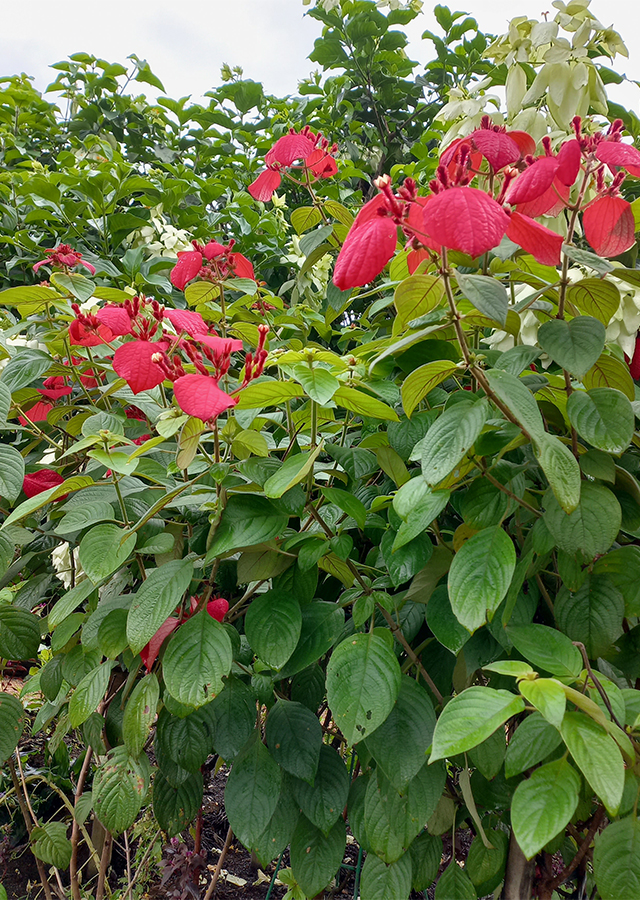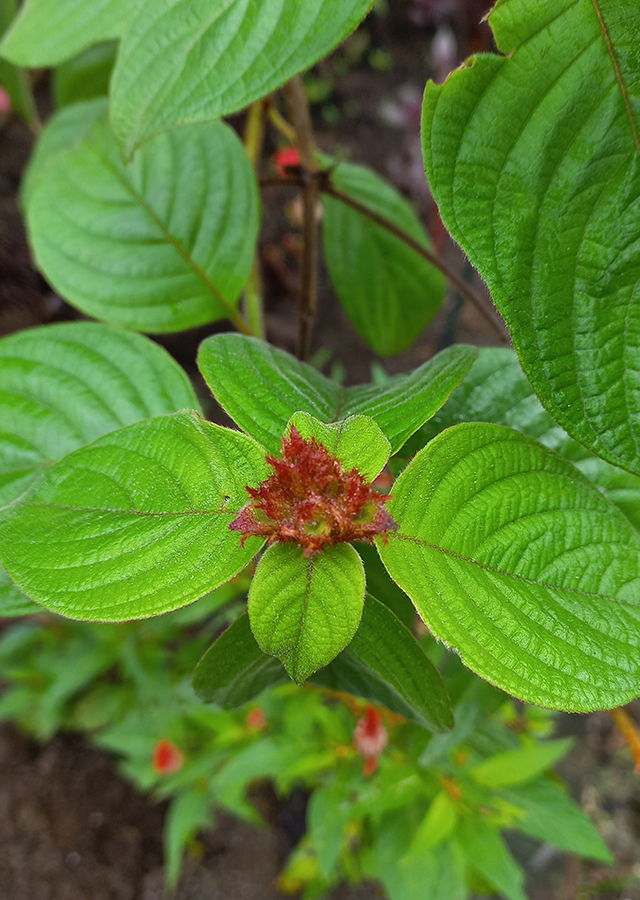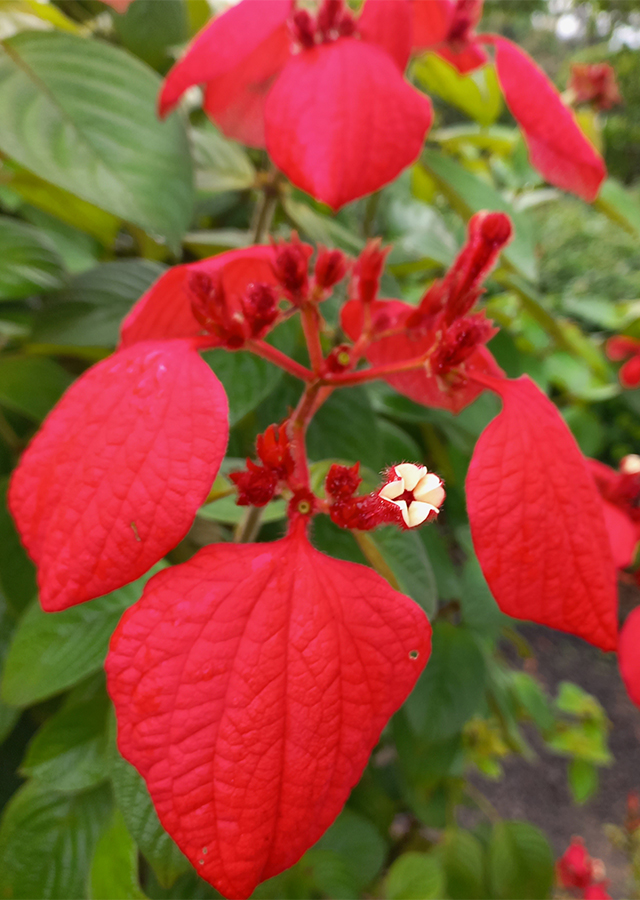Red Flag Bush
Mussaenda erythrophylla Schumach. & Thonn.
Rubiaceae
Location in our garden
Principal



Synonym
Mussaenda fulgens R.Br. ex Tedlie
Mussaenda splendida Welw.
Habitus
Shrubs. An evergreen, perennial woody shrub, growing 1.5-8 m tall
Part Used
Leaves
Roots
Stem
Growing Requirements
Full Sunshine
Habitat
Riverbanks
Forest
Roadside
Grassland
Terrestrial
Overview
Mussaenda erythrophylla is native to western tropical Africa. It was introduced and cultivated as an ornamental in tropical and subtropical areas and now can be found naturalized in Central and South America, the West Indies, China, India, French Polynesia and Fiji. A popular plant grown in parks and gardens across tropical and subtropical regions of the world. Their showy and colourful inflorescences (from bright crimson to deep red) make this plant attractive for horticulturalists. It is a species of environmental concern because it is a vigorous plant that can form dense thickets up to 10 m high that can easily outcompete and displace other vegetation including native plant species. It is used in traditional medicine and also as dye. Its leaf extract is used as food dye, and the red sepal is used as fabric dye.
Vernacular Names
Flor de trapo (Spanish), Ashanti blood (Jamaica), Colombina roja (Puerto Rican).
Agroecology
Red flag bush can be found growing in old cocoa plantations with remnants of original forests, secondary bushes along creeks, forest edges, riverbanks, shrubby savannahs and in thickets along roadsides. Prefers to grow in warm and moist habitats, but it is also adapted to semi-deciduous and dry sites. It grows best in areas with full sunlight and porous soil with pH in the range 7-8.5, with mean annual temperature of 17-28 °C. Tolerates to alkaline-neutral soil reaction, and light to medium soil texture.
Morphology
- Root - a branched tap root system
- Stem - drooping or climbing branches and copiously pilose branchlets.
- Leaves - 5-12 cm long and 3-8 cm wide, oval-ovate to almost cordate (when young), acuminate, base obtuse to slightly decurrent, copiously pilose, prominently veined; petioles, 1-6 cm long; stipules, interpetiolar.
- Flower - inflorescences, terminal, several-flowered, branched, corymbose cymes; calyx, 5-lobed, one of the lobes (rarely 2) enlarged, petal-like, up to 9 cm long and 6.5 cm wide, ovate-lanceolate, lax-pendant, bright red above and somewhat paler beneath, palmately veined, pubescent, the other lobes, up to about 1 cm long and 2 mm wide, narrowly linear-lanceolate, caducous, bright red, calyx tube reddish-pubescent; corolla, about 2.5 cm long, tubular, 5-lobed, red-pubescent outside with tube white or pale-yellow within distally; stamens 5, included.
- Fruit - a berry.
- Seed - numerous minute seeds.
Cultivation
Generative propagation is by seed, and vegetative propagation is by stem cutting and layering.
Chemical Constituents
Alkaloids, phytosterols, cardiac glycosides, flavonoids, tannins, triterpenoids, glycosides, mussaendosides A-C, M and N with cyclolanostene type aglycone and aureusidin, iridoid glycosides, β-sitosterol, 5 hydroxy-7, 4'-dimethoxy flavones, 3- iso cumaryloxy – cyclopropane-1-oic acid and 4 -hydroxy-3-methoxy cinnamic acid.
Traditional Medicinal Uses
- It is used in traditional medicine for cough and jaundice.
- Roots are diuretic.
- Studies showed that the plant has anthelmintic, hepatoprotective, antioxidant, anti-arthritic, and antileishmanial effects.
Part Used
Reference Sources
- Flora Fauna Web. (2019). Mussaenda erythrophylla 'Dona Luz'. https://www.nparks.gov.sg/florafaunaweb/flora/2/2/2252. 25-11-2021.
- Gunasekaran, S., et al. (2015). The genus Mussaenda: A phytopharmacological review. Journal of Chemical and Pharmaceutical Research, 7(7):1037-1042.
- Kew Royal Botanic Gardens. (2021). Plants of the World Online: Mussaenda erythrophylla Schumach. & Thonn. http://www.plantsoftheworldonline.org/taxon/urn:lsid:ipni.org:names:756618-1. 25-11-2021.
- Sandoval, Julissa Rojas. (2021). Invasive Species Compendium: Mussaenda erythrophylla (red flag bush). https://www.cabi.org/isc/datasheet/120124#tosummaryOfInvasiveness. 25-11-2021.
- Stuartxchange. (2015). Philippine Medicinal Plants: Doña Trining. http://stuartxchange.com/DonaTrining. 29-10-2021.


